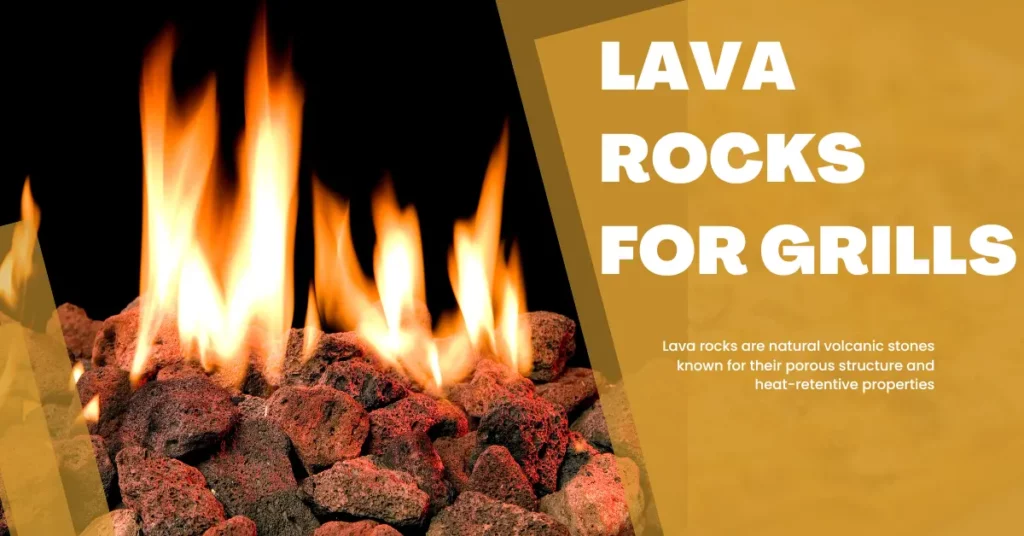This post may contain affiliate links. If you use these links to buy something we may earn a small commission. Thanks.
Once a staple in backyard barbecuing, lava rocks dominated the grilling world during the 1980s and 1990s. These porous volcanic stones were the go-to solution for grill enthusiasts who wanted the smoky flavor of charcoal without giving up the convenience of gas grills. However, as grilling technology advanced, lava rocks gradually disappeared from mainstream use. This article explores their rise, fall, and whether they still have a place in the grilling world today.
What Are Lava Rocks
Lava rocks are natural volcanic stones known for their porous structure and heat-retentive properties. When used in grills, they acted as a heat diffuser between the gas burners and the cooking surface. Lava rocks absorbed and retained heat, allowing for consistent cooking temperatures. Additionally, as food drippings hit the hot stones, they vaporized, adding a smoky, flavorful essence to grilled foods—mimicking the effect of cooking over charcoal.

Why Lava Rocks Became Popular
1. Heat Retention and Distribution
Lava rocks were prized for their ability to retain and distribute heat evenly across the grill. This ensured that food cooked thoroughly, reducing the risk of cold spots.
2. Flavor Enhancement
The vaporization of grease and drippings on the hot rocks produced flavorful smoke, enhancing the taste of grilled food. For many, this was the best of both worlds: the flavor of charcoal grilling with the ease of gas.
3. Cost and Availability
Lava rocks were affordable and widely available, making them an accessible option for the average grill owner. They could also be reused multiple times, further increasing their appeal.
Issues with Lava Rocks
Despite their popularity, lava rocks had several downsides that led to their decline:
1. Maintenance Challenges
Grease and food particles often collected on lava rocks, leading to flare-ups that could burn food and create safety hazards. Cleaning lava rocks was tedious and time-consuming, as they had to be soaked and scrubbed thoroughly to remove grease.
2. Hygiene Concerns
The porous nature of lava rocks, while excellent for heat retention, also made them a breeding ground for bacteria. Over time, accumulated grease and food debris could harbor harmful pathogens, raising concerns about food safety.
3. Durability Problems
Lava rocks were prone to crumbling and breaking down after repeated use. Regular replacement became necessary, which offset their initial cost-effectiveness.
The Shift to Modern Alternatives
As these issues became more apparent, manufacturers and consumers began looking for alternatives that offered the same benefits without the drawbacks. Here are some of the innovations that replaced lava rocks:
1. Ceramic Briquettes
Ceramic briquettes emerged as a superior alternative. These man-made stones offered similar heat retention and even distribution but were easier to clean and longer-lasting. Unlike lava rocks, ceramic briquettes did not crumble or harbor bacteria as easily.
2. Flavorizer Bars
Weber, a leading name in grilling, introduced flavorizer bars as a replacement for lava rocks. These metal bars, placed directly over gas burners, served a dual purpose: they vaporized drippings to enhance flavor and protected the burners from grease buildup.
3. Infrared Technology
Infrared burners revolutionized gas grilling by providing direct and even heating without the need for intermediary materials like lava rocks. This technology eliminated flare-ups and ensured consistent cooking temperatures.
Why Lava Rocks Faded Out
The decline of lava rocks can be attributed to advancements in grill technology. Modern alternatives addressed their shortcomings while improving safety, convenience, and durability. Additionally, the growing focus on hygiene and maintenance further pushed consumers toward newer solutions.
Can Lava Rocks Still Be Used?
Although they are no longer a mainstream choice, lava rocks are still available for purchase and can be used in older grills that rely on them. For those who still want to use lava rocks:
- Ensure Proper Cleaning: Soak the rocks in soapy water and scrub them regularly to prevent grease buildup.
- Replace When Necessary: Discard rocks that are crumbling or excessively greasy.
- Use Safely: Monitor the grill closely to avoid flare-ups caused by dripping grease.
In niche situations, such as camping or DIY grill setups, lava rocks may still offer a practical and cost-effective solution.
Conclusion
Lava rocks played a pivotal role in the evolution of gas grilling, providing an affordable and effective way to enhance flavor and distribute heat. However, as technology advanced, their limitations became increasingly apparent. While modern alternatives like ceramic briquettes and flavorizer bars have largely replaced them, lava rocks still hold a nostalgic charm for some grilling enthusiasts. For those who miss their smoky flavor and rustic appeal, lava rocks remain a reminder of how far grilling technology has come.
